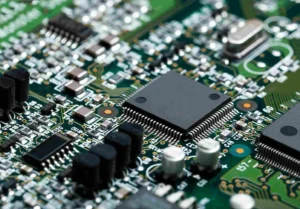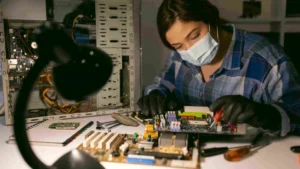Automatic Test Equipment (ATE) is an essential tool for the modern manufacturing industry. It is a device that performs automated testing of electronic components, circuits, and systems to ensure their quality and performance.ATE is an essential component of DFT because it enables the testing of electronic devices and systems using software-controlled test procedures. By incorporating DFT principles, design engineers can improve the testability of a device or system and reduce the cost and time required for testing. ATEs are used to verify that the electronic devices function correctly and can handle the tasks they are designed for. They are employed in various industries, including aerospace, automotive, communications, and consumer electronics.
Also Read DFT Scan Types And Their Mechanism
The primary function of an ATE is to simulate real-world conditions and environments that an electronic device may encounter during its lifetime. This allows engineers and manufacturers to test their products under various conditions to determine their reliability and performance. ATEs help manufacturers detect any defects or errors in their products before they are shipped to the customer, thereby reducing the risk of product failures and customer complaints.
Components Of Automatic Test Equipment
Automatic Test Equipment is a sophisticated system used to automate the testing of electronic devices and components. It is composed of various components, each with a specific function that contributes to the overall testing process. The primary components of an ATE include:
- Test instruments: These are electronic devices that measure and analyze the electrical signals produced by the device under test. The type of test instruments used depends on the nature of the device being tested, but common examples include digital multimeters, oscilloscopes, and signal generators.
- Test fixtures: These are mechanical fixtures that hold the device under test and provide electrical connections to the test instruments. The test fixtures are designed to ensure that the device is held in a secure position and that the electrical connections are stable and accurate.
- Control software: This is the software that controls the ATE and automates the testing process. The software is designed to communicate with the test instruments and the test fixtures, providing instructions for testing the device under test and collecting data from the tests.
- Interface hardware: This is the hardware that connects the ATE to the device under test. The interface hardware is typically customized for each device being tested, and it may include connectors, cables, and other components.
How Does It Work?
Automatic Test Equipment (ATE) works by automating the testing process of electronic devices and components. The basic steps involved in the ATE process are: developing a test program, setting up the Device Under Test (DUT) on the test fixture, testing the DUT by applying test signals and measuring the responses, analyzing the test results, and storing the test data and generating a test report. The test program specifies the tests to be performed, the test parameters, and the expected results. After testing, the ATE analyzes the results, generates a pass/fail report, and stores the data in a database or local storage device.
The ATE automates the testing process, which increases testing efficiency, accuracy, and repeatability. ATEs are designed to simulate the real-world operating conditions of electronic devices and components, which allows manufacturers to identify any potential issues before the device is shipped to the customer. This helps to reduce the risk of product failures, improve product quality, and enhance customer satisfaction. ATE plays a crucial role in implementing DFT by providing the hardware and software tools required to perform comprehensive testing of electronic devices and systems. The ATE system typically includes test instruments such as signal generators, oscilloscopes, and spectrum analyzers, as well as software tools for test automation, data analysis, and reporting. um analyzers, as
Conclusion
If you want to know more about chip manufacturing processes or are willing to make a career in the semiconductor industry, then Chipedge is the right place for you. It is one of the best training and placement institutes in Bangalore that brings a wide range of job-oriented courses in Bangalore for both freshers as well as professionals. Grab the opportunity now.















